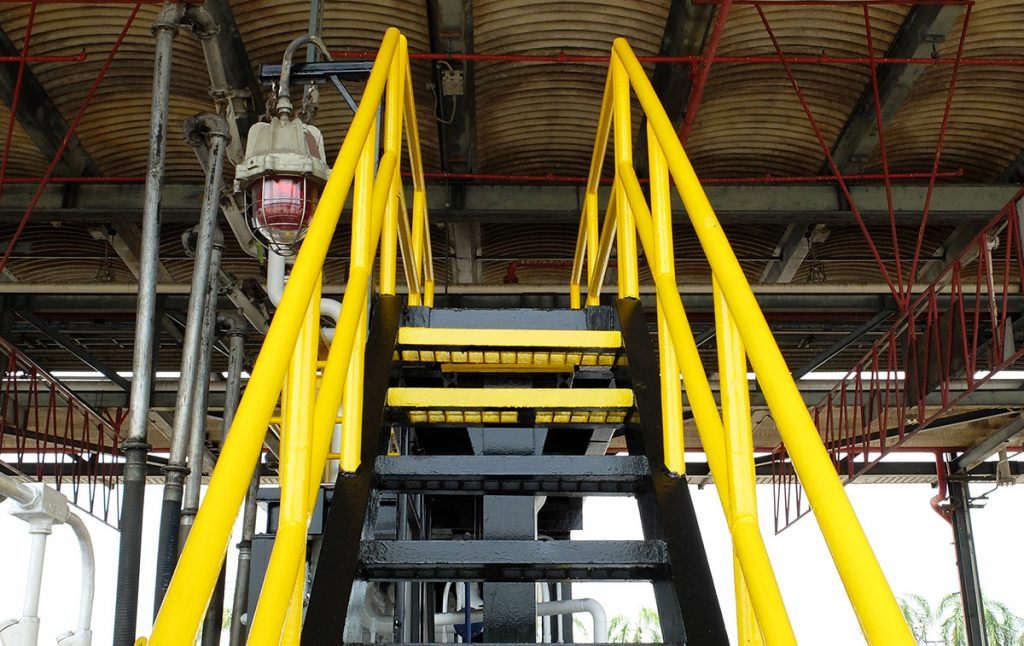Adding Protective Barriers for Worker Protection
 When planning your commercial roofing project, don’t forget to factor in the need for OSHA-compliant rooftop safety rail systems that can prevent serious injuries or death from falls.
When planning your commercial roofing project, don’t forget to factor in the need for OSHA-compliant rooftop safety rail systems that can prevent serious injuries or death from falls.
As part of our discussion about your project needs, Tennessee Roofing and Construction typically incorporates fall protection into the design, fabrication, and erection of buildings on the commercial and industrial general contracting projects we manage.
Designing and installing exactly what you need is critical to meet federal regulations and protect your workers, contractors, and visitors to industrial and commercial buildings from potential fall hazards.
Types of OSHA Compliant Safety Rails Systems
Common safety rail systems include Safety Handrails, Mezzanine gates, pallet gates, dock gates, stairs, platforms, and fixed ladders. Safety guardrail systems serve to not only offer protection against accidental falls but also prevent restrict access to unsecured, hazardous, or otherwise sensitive sections of commercial and industrial roofing.
Steel railing may be freestanding, portable, or permanently attached to roof ladders. Safety gates may sometimes be added to offer additional precautions. Stair platforms and crossovers can be added to allow access over pipe racks, air ducts, or other obstructions. Workers may be exposed to potential electrocution hazards from contact with an electrical conduit that may be buried in old roofing material, not to mention the ever-present hazard of contact with overhead power lines. Safety railing systems help to prevent such contact by guiding workers to the safest routes to access roofing areas.
These may arrive as modular systems for assembling on-site or, if your structure is being constructed from scratch, these systems can be integrated within the overall welding process.
Most safety rail systems involve painting in safety yellow powder coat, making them impossible to miss.
OSHA governs the use of guardrail systems around roof opening and at the roof perimeter. Guardrail systems must be able to withstand a 200-pound force in any outward or downward direction within 2 inches of the top edge. Guardrail systems must be surfaced to prevent punctures and lacerations and to prevent clothes from snagging.
Employers are also tasked with protecting workers from falling through skylights and other openings on roofs. Secure footing and proper labeling of hazards are among the main considerations that OSHA factors into the protections.
A great thing about these safety rails system is their passivity: Once installed, they work to reliably offer protection with just routine maintenance consideration.
Things to Consider When Designing Safety Railings
It is important, when designing these systems, to factor in the need to securely install the railing systems without penetrating the roof.
At the design stage, the overall look and layout of safety railing should factor into the overall aesthetic vision for your commercial or industrial building so that these necessary features do not visually clash with the desired effect.
Future needs should also factor into designs so rail sections can be moved to allow for expansion, reconfiguration, or the necessity to service or replace equipment, machinery, or conveyors. Moving or replacing these safety handrails should not involve a major undertaking and won’t if future contingencies factor into designing where they go.
When describing the safety railing system you want, make sure you tell the contractor about specialty needs that offer additional protection for workers. In specific instances, OSHA may require the inclusion of a personal fall arrest system to stop a fall before the worker strikes a lower level. Typically, this involves the use of a harness worn by a worker and a shock-absorbing lanyard connected by a snap hook. Systems must balance the need for workers to operate efficiently with limiting the distance they could fall. When employers use fall restraint systems to prevent workers from reaching unprotected sides or edges, they must train workers how to determine the appropriate lanyard length prior to beginning work.
Worker safety also factors into the potential for falling debris to hit workers on the ground below. Such debris can also present a tripping hazard and contribute to falls.
Learn More about Worker Safety and OSHA Requirements
OSHA has compliance assistance specialists throughout the nation located in most OSHA offices. Compliance assistance specialists can provide information to employers and workers about OSHA standards, short educational programs on specific hazards or OSHA rights and responsibilities, and information on additional compliance assistance resources. For more details, call 1-800-321-OSHA (6742) to contact your local OSHA office.
Ask Tennessee Roofing and Construction About Our Roof Safety Rail Systems
When you call us, we can guide you through the various options and help you to decide which are best for your specific needs. For additional information on our contracting and commercial roofing services in Chattanooga, call Tennessee Roofing and Construction at 423-842-8826 or contact us online.
Copyright: jackritw / 123RF Stock Photo


